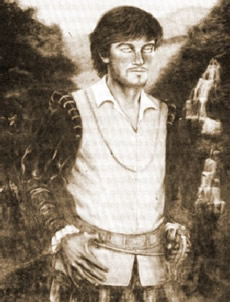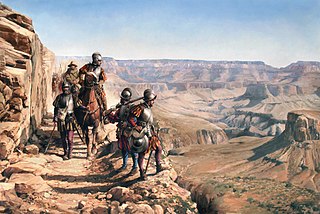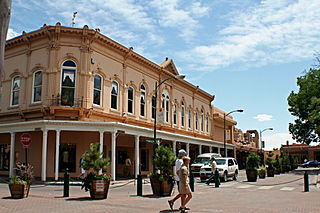
Santa Fe de Nuevo México was a province of the Viceroyalty of New Spain, and later a territory of independent Mexico. The first capital was San Juan de los Caballeros from 1598 until 1610, and from 1610 onward the capital was La Villa Real de la Santa Fe de San Francisco de Asís. The naming, capital, the Palace of the Governors, and rule of law were retained as the New Mexico Territory, and the subsequent U.S. State of New Mexico, became a part of the United States. The New Mexican citizenry, primarily consisting of Hispano, Pueblo, Navajo, Apache, and Comanche peoples, became citizens of the United States as a result of the Treaty of Guadalupe Hidalgo.

Juan de Oñate y Salazar was a conquistador from New Spain, explorer, and colonial governor of the province of Santa Fe de Nuevo México in the viceroyalty of New Spain. He led early Spanish expeditions to the Great Plains and Lower Colorado River Valley, encountering numerous indigenous tribes in their homelands there. Oñate founded settlements in the province, now in the Southwestern United States.

For the Texas State Park see Big Bend Ranch State Park.

A presidio is a fortified base established by the Spanish in areas under their control or influence. The term is derived from the Latin word praesidium meaning protection or defense.
The Pueblo Revolt of 1680—also known as Popé's Rebellion—was an uprising of most of the indigenous Pueblo people against the Spanish colonizers in the province of Santa Fe de Nuevo México, present day New Mexico. The Pueblo Revolt killed 400 Spanish and drove the remaining 2,000 settlers out of the province.
Quivira is a place named by explorer Francisco Vásquez de Coronado in 1541, for the mythical "Seven Cities of Gold" that he never found. The location of Quivira is believed by most authorities to be in central Kansas near present-day Lyons extending northeast to Salina. The Quivirans were the forebears of the modern day Wichita Indians and Caddoan tribes, such as the Pawnee or Arikara. The city of Etzanoa, which flourished between 1450 and 1700, is thought to be part of Quivira.

The Camino Real de Tierra Adentro was a 2560 kilometer long trade route between Mexico City and San Juan Pueblo, New Mexico, from 1598 to 1882.
The Piro Pueblo of Senecú was the southernmost occupied pueblo in New Mexico prior to the Pueblo Revolt of 1680. It was located on the west bank of the Rio Grande within sight of San Pasqual. Colonial Spanish documents consistently place the pueblo opposite of Black Mesa, which is near San Marcial. Due to changes in the floodplain and the establishment of San Marcial, however, no surface remains of the pueblo survive in the area.
Antonio de Espejo was a Spanish explorer who led an expedition into New Mexico and Arizona in 1582–83. The expedition created interest in establishing a Spanish colony among the Pueblo Indians of the Rio Grande valley.
Luis de Carvajal was governor of the Spanish province of Nuevo León in present-day Mexico, an alleged slave trader, and the first Spanish subject known to have entered Texas from Mexico across the lower Rio Grande.

Arizpe is a small town in Arizpe Municipality in the north of the Mexican state of Sonora. It is located at 30°20'"N 110°09'"W. The area of the municipality is 2,806.78 sq.km. The population in 2005 was 2,959 of which 1,743 lived in the municipal seat as of the 2000 census.

Francisco de Ibarra was a Basque explorer, founder of the city of Durango, and governor of the Spanish province of Nueva Vizcaya, in present-day Durango and Chihuahua.

San Lazaro is an archaeological site of pueblos in the U.S. state of New Mexico. Located in the basin of the Galisteo River south of Santa Fe, it was home to a clan of the Tanoan peoples at the time of Spanish colonial contact in the 16th century. It was abandoned in the aftermath of the Spanish reconquest of the area after the 1680 Pueblo Revolt, its people believed to have eventually settled at First Mesa among the Hopi. The site was declared a National Historic Landmark in 1964.

Chihuahua, officially the Free and Sovereign State of Chihuahua, is one of the 31 states of Mexico. It is located in Northwestern Mexico and is bordered by the states of Sonora to the west, Sinaloa to the southwest, Durango to the south, and Coahuila to the east. To the north and northeast, it has a long border with the U.S. adjacent to the U.S. states of New Mexico and Texas. Its capital city is Chihuahua City.
The Querechos were a Native American people.
Jusepe Gutierrez ,) was a Native American guide and explorer. He was the only known survivor of the Umana and Leyba expedition to the Great Plains in 1594 or 1595. In 1599 he guided Vicente Saldivar and in 1601 Governor Juan de Oñate on expeditions to the plains.
Gaspar Castaño de Sosa was a Portuguese conquistador, reputed slaver, and explorer who attempted to establish a colony in New Mexico in 1590.
The Manso Indians are an indigenous people who lived along the Rio Grande, near Las Cruces, New Mexico, from the 16th to the 17th century, and were the one of the groups settled at the Guadalupe Mission in what is now Cd. Juarez, Mexico. Some of their descendants remain in the area to this day.
La Junta Indians is a collective name for the various Indians living in the area known as La Junta de los Rios on the borders of present-day West Texas and Mexico. In 1535 Alvar Nunez Cabeza de Vaca recorded visiting these peoples while making his way to a Spanish settlement. They cultivated crops in the river floodplains, as well as gathering indigenous plants and catching fish from the rivers. They were part of an extensive trading network in the region. As a crossroads, the area attracted people of different tribes.










